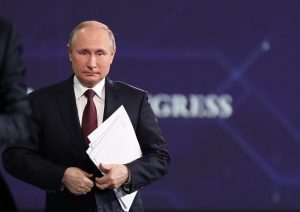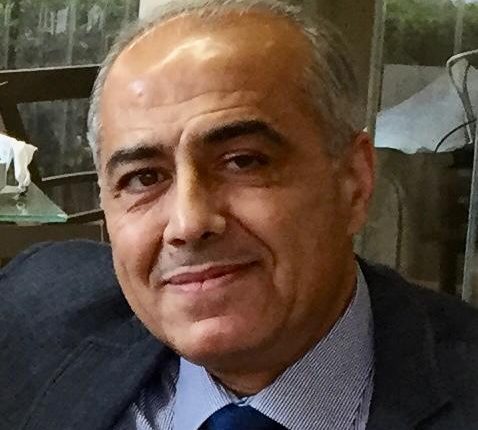UPCOMING US-RUSSIA GENEVA TALKS AND IDEOLOGICAL BIAS
By General Monzer El Ayoubi
Translation: Pierre A. Sarkis

Thursday, December 30, 2021, as if the planet had stopped its orbit for 50 minutes, awaiting the conclusion of a phone call between the leaders of its multipolar powers, the President of the United States and his Russian counterpart Vladimir Putin. The slackline is tight between the docks of Moscow and Washington, as both head towards the confrontation line in the middle, fluctuating, cautious, using a seat belt to prevent falls, with increasing tensions triggering resonance causing the wire to cut off. The dynamics of strategic balance impose an additional energy which prevents recoil to the military, and raises the standard of voltage to compensate for deficiencies, while avoiding friction requires a layer of diplomatic grease.
With bare feet, Ukrainian President Zelensky stands in an unenviable position, betting on the Vienna talks on the 10th of this month, to weigh a direct negotiating path that reconciles the preservation of his country’s sovereignty and the requirements of Russian national security, which allows the prevention of an unrepelled invasion nightmare. In parallel, the US is working on uniting Europe behind it, by amassing a joint military force on the Ukrainian land borders and the Black Sea under the umbrella of NATO, because of the impossibility of accepting Ukraine’s membership in it, avoiding the breakdown of the video-phone network and in fear of losing the coverage from the Kremlin station. On the other hand, the negotiating table will not be round without a head or aspects to its duality, as President Putin is a central figure who imposes equality with his counterpart, US President Biden; he is not a symbol of Russian Mythology like King Arthur of England, nor the Kremlin the fortress or the court of “Camelot” the work of pure imagination.
Next, whatever the degree of the threat between the two arch-rivals, raising mutual concerns at the strategic and geopolitical levels does not mean weakness but parity, which imposes an agreement even in the broad lines, equal, a bridge of balance leading to the unity of sizes in quantity and equality, equaling zero. But it does not mean equality as in the principle of equality in units of mathematics (the number of countries in one alliance). As for military strategic valence and parity, it is generic, proactive and analogue (one nuclear strike offset by another counterstrike), and nonviolence is the option of the powerful. In congruence is a Russo-Chinese alignment in the unity of characteristics and interests, a relationship of similarity or balance to avoid bias, and could be used between the logic and illogic in the sense of contradiction.
In a related context, the issues at stake are an extension of the strategic security and economic dialogue of the Biden-Putin summit in Geneva in June 2021. The political or diplomatic level of the two teams of the 10th of this month’s talks will be at the rank of ministers of defense and foreign affairs, followed two days later on 12/01/2022 by a second meeting between Russia and NATO countries, then between her and the Organization of Security and Cooperation (OSC) in Europe, and both of them, NATO and the OSC include the US in their memberships, if not under US cloak.
Alternatively, the succession of meetings within short time intervals indicates the high temperature on the scale of military conflict, and its reduction from the Russian perspective requires the following:
• Stop NATO’s Eastward expansion without touching the borders of Russia and Europe.
• Reduce the qualitative military deployment and military bases.
• Stop the supply of advanced missile and armored weapons to the Ukraine.
• Ban on the deployment of short and medium-range ballistic missiles 500/5000 km in Europe. In other words, the renewal of the INF Treaty signed by Washington and Moscow in 1987.
• Stop reconnaissance flights of spy planes, as well as, military provocations and western training exercises, particularly in the vital range and the Black Sea.
In the interim, the on the field dialogue at the Ukrainian borders will be in a state of freeze despite President Putin’s decision to follow up on the countermeasures. Noting that the draft proposals for a new treaty with the US and a tactical agreement with NATO of the type of “balance of interests” were lodged and announced by Moscow, with a one-month deadline to respond to it, conclusive to a lengthy, tricky and circular dialogue that may start and end at the same point, without crossing the lines of crisis.
On the intelligence side, reports of the CIA’s “Eye of America on the World” from its secret European stations, particularly in the Romanian capital of Bucharest, exclude the hypothesis of the invasion now, and Moscow could adopt the gradual gnawing tactic, despite the mobilization of Russian military command in the conflict zone with Kiev with more than eight brigades of infantry, as well as, missile brigades and electronic warfare. Conversely, although Washington and NATO Command condemned the Russian Army’s moves, they will not slip into a war, even a limited one for the sake of defending Ukraine and the response will be by imposing severe economic sanctions. This is what President Biden warned about during his recent conversation with his Russian counterpart, while the latter’s answer was that Russia is in the clear strategic mind, treating the Ukraine as a geographical area within a vital range, and the military option is a decision in the event of a threat to Russian national security.

In the collateral damage, a kind of engagement was opened by Western or anti-government forces a day before in Kazakhstan, following the outbreak of anti-government protests that included terrorist acts of rioting and burning government buildings where live bullets were used, prompting President Kassim Tokayev to seek Russian support. Yesterday, Russian forces entered the capital Nursultan, in accordance with the Collective Security Treaty (CST), under Moscow’s leadership of a coalition comprising Russia, Kazakhstan, Belarus, Tajikistan and Armenia. In an additional reading, Moscow’s month-long deadline for the US-NATO Alliance appears to meet Chinese-coded conditions, as President Putin’s participation in the opening of the Winter Olympics to be held in February in Beijing, will translate into the announcement of a more assimilated alliance by raising it to a new level of military and economic cooperation and expanding it to include technological and financial cooperation. This is in tandem with a US diplomatic boycott that Chinese President Xi Jinping called an ideological bias and malicious intentions.
Finally, Ukraine is not the sole target of the Russian sniper, and getting a hand on it directly or indirectly means preparing to change the geopolitical situation in the European East. Thus, European security will hover between a Russian-NATO duality, as well as, the dependency of the adopted economy on Russian gas supplies from the North Stream 1/2 pipelines. More importantly, the US and its NATO allies are being handcuffed from expanding into the orbit of Russian influence, Georgia and Moldovia, while forcing its medium and short-range ballistic missiles to remain outside The Old Continent.
Beirut, 07/01/2022
Scholar in Security and Strategic Affairs

